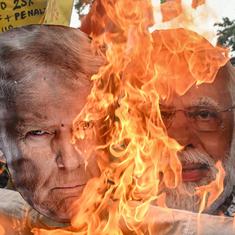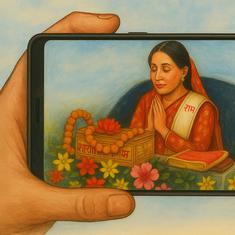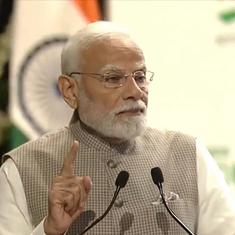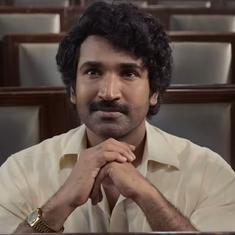Tamil director Premkumar’s 2018 hit 96 has two composers. The official one is Govind Vasantha, whose tunes were warmly received. The unofficial one is Ilaiyaraaja, the legendary musician who ruled the Tamil film industry between the 1970s and ’90s.
Ilaiyaraaja, who was born in 1943, has by no means retired from making music or churning out the hits. However, his songs from previous decades also remain hugely popular, and show up in contemporary films alongside original soundtracks. Ilaiyaraaja’s stamp is all over 96, about childhood sweethearts who reunite at a school reunion. Ilaiyaraaja’s heartfelt tunes are not merely used as timestamps to date the early years of courtship between Ram (Vijay Sethupathi) and Janaki (Trisha). They also serve as powerful reminders of an era in Tamil cinema when romance was synonymous with Ilaiyaraaja.
The first Ilaiyaraaja number in 96 is the interlude and charanam (or stanza) of Putham Puthu Kalai from Alaigal Oivathillai (1981). “I needed a lengthy background tune to segue to the flashback to the childhood of the two characters, but it had to be represent a young woman’s point of view,” 96 director Premkumar explained. “The way Ilaiyaraaja has composed the interlude and the lines that follow in Putham Puthu Kalai seemed to fit perfectly. The song is a romantic number, but the charanam, heard on its own, seems to speak of the desires of a woman’s mind and heart.”
The name of Trisha’s character, Janaki, is another tribute to the singer whose rich and textured voice featured in numerous Ilaiyaaraja hits. “The lead female character is called Janaki because her parents, like my parents, are music lovers and fans of Janakiamma,” Premkumar said. “So this helped me narrow my list of Ilaiyaraaja songs to only those sung by Janakiamma.”
Premkumar is hardly the only director to pay a double-toned tribute to Ilaiyaaraja in recent years. Several Tamil filmmakers who grew up in the ’80s and ’90s are ensuring that Ilaiyaaraja’s music lives on in their films. A nostalgia for their formative years has combined with a yearning to produce the sonic landscape suggested by Ilaiyaaraja’s music. These include Thiagarajan Kumararaja (Super Deluxe, 2019), Selvakannan (Nedunaalvadai, 2019), A Kesavan (Avalukkenna Azhagiya Mugam, 2018) and Chezhiyan (To-Let, 2017).
The songs are almost never remixed, as is the fashion in Bollywood. In Super Deluxe, Ilaiyaraaja’s tunes fit snugly into settings vastly different from the films for which they were originally composed. The oomph-filled and conversational opening portion of Vanithamani Vanamohini from Vikram (1986) is used in the scene in which a bunch of boys get together to watch a porn film. The original has Arun (Kamal Hassan) and his wife (Ambika) romancing in the forest as an assassin attempts to kill them.
The sexually-charged Maasi Maasam, from Rajinikanth’s Dharma Durai (1991), plays in the background as Vijay Sethupathi’s transgender character Shilpa deftly drapes her saree. Her wife (Gayathrie) watches in wonderment as the “oohs” and “aahs” of the track build up the tension. The original track had Rajinikanth and Gautami canoodling as the night wears on.
Nedunaalvadai uses Intha Poovukoru from Poovarasan (1996). It plays briefly in a bus where Amudha (Anjali Nair) spots her lover Elango (Elvis Alexander) in the front seat. Their love story is in its initial stages, and the song offers an indication of their mutual frisson.
A version of Raman Andalum from Mullum Malarum (1978) plays at the end of the Rajinikanth-starrer Petta (2018). J Mahendran’s Mullum Malarum had one of Rajinikanth’s most iconic characters, a proud and possessive brother.
The most recent tribute is Saravana Rajendran’s April release Mehandi Circus. The 1990-set film traces the relationship between a circus performer (Shweta Tripathi) and a cassette shop owner (Madhampatty Rangaraj). “Nothing describes the 1980s and the 1990s in Tamil Nadu better than a popular Ilaiyaraaja number from that time,” Rajendran told Scroll.in.
Ilaiyaraaja’s music and his legacy are both present in Mehandi Circus. The cassette shop owner, Jeeva, only needs a phrase to guess the title, film and singers of any Ilaiyaraaja song. Jeeva also helps the men in his village successfully woo the women of their choice by curating mixtapes of Ilaiyaraaja songs.
Like 96, Mehandi Circus has original tunes, by Sean Roaldan. But for the theme song of Jeeva’s love for Mehandi (Tripathi), Rajendran has used O Paapa Laali from Idhayathai Thirudathey (1989), the Tamil dubbed version of Mani Ratnam’s Telugu romance Geethanjali.
“Like many others, I grew up listening to Ilaiyaraaja’s songs,” Rajendran said. “They shaped my life, my experience, my thoughts. And it wasn’t like we could hear these songs whenever we wanted. In villages, big films would rarely get released. We’d first hear the songs somehow and after many weeks, the film would be re-released and that’s when they’ll be screened in our village. Since we cannot afford to watch multiple shows, we’d go stand near the theatres whenever our favourite songs would play.”
A love for Ilaiyaraaja’s music is inextricably woven into Rajendran’s memories of his feelings for a woman from his village. “After I watched Idhayathai Thirudathey, this song would play in my head every time I’d think of her or see her, and the song has stayed with me ever since,” Rajendran recalled. “When I wrote this script, I felt it was the perfect song to describe Jeeva’s love for Mehandi.”
Before AR Rahman burst onto the scene with Roja in 1992, followed by several new composers, there was Ilaiyaraaja. He made his debut with Annakili in 1976, and transformed Tamil film music with his unusual orchestration and his ability to compose songs across genres and styles.
“He introduced western classicism and symphony in interludes and presented traditional rustic folklore in the form of melody or in a love song,” music composer James Vasanthan observed. “Before he arrived, composers like KV Mahadevan and MS Viswanathan were following a set structure of a repeating pallavi followed by very short interludes before the charanams – a kind of 1-2-1 structure. Ilaiyaraaja broke those norms. He’d create competing, different, yet beautiful interludes in the same song, for instance. In Ilamai Enum Poongatre, which is a romantic song from a woman’s point of view, he created interludes and background vocals using voices from a female chorus. And in Kalaivaaniye, which is about a musician’s comeback, the entire song is composed of swaras that are in ascension only.”
Vasanthan paid tribute to Ilaiyaraaja’s tunes in M Sasikumar’s Subramaniapuram (2008) and Sasikumar’s production, Pasanga (2019). Subramaniapuram is set in the 1980s, and Ilaiyaraaja looms large in the backdrop as Azhagu (Jai) woos Thulasi (Swathi Reddy). Siru Ponmani Asaiyum from Kallukkul Eeram (1980) plays out as the couple steal glances.
“James Vasanthan had actually prepared another song for the situation, but I felt this old track fit better,” Sasikumar recalled. “When I told him that, he graciously accepted it as he too is a huge Ilaiyaraaja fan. And since the story of the film is set in the 1980s, I felt it is rather apt for us to use Raja sir’s old songs.”
Vasanthan’s composition Kangal Irandal, the most well-known tune from Subramaniapuram, is also in the mould of Ilaiyaaraja. Sung by Belly Raj and Deepa Miriam, the song has a retro sound and differently structured interludes that match the passion between the lovers.
Ilaiyaraaja tracks are repurposed for Pasanga, directed by Pandiraj, produced by Sasikumar and composed by Vasanthan. Ilaiyaraaja songs are heard in the form of ringtones, among them, O Paapa Laali from Geethanjali, in a romantic sub-plot.
“No music composer can compose without building on what Raja sir has contributed,” Sasikumar noted. “When I was at St Peters in Kodaikanal, we would wait eagerly for the next Ilaiyaraaja album. One of us would somehow get it and we’d sit together in our dormitories and listen to the songs together.”
Ilaiyaraaja is soldered into memories of childhood for many of the filmmakers who have turned to his songs. “AR Rahman arrived only when I was finishing school,” 96 director Premkumar said. “So when it comes to Ilaiyaraaja, I just know which song to play for what mood. It wasn’t something I had to work hard at.”
Ilaiyaraaja has a song for every occasion, Mehandi Circus director Rajendran added. “His music is so accurate in its expression of the emotions we feel. This is why even though we have heard a lot of good music from many great composers, we continue to go back to Ilaiyaraaja.”
In 96, Yamunai Yaatrile from Mani Ratnam’s Thalapathi (1991) becomes a motif to explore Ram’s enduring love for Janaki. In Thalapathi, the song expresses the yearning that Subbalakshmi (Shobhana) feels for Surya (Rajinikanth).
In 96, Janaki refuses Ram’s request to sing Yamunai Yaatrile since he doesn’t ask her directly. Instead, she sings a stanza from Aasai Adhigam from Marupadiyum (1993). The lyrics from Aasai Adhigam also speak to Ram’s predicament – he lacks the courage to express his feelings for Janaki. She continues to hold back even when she finally meets Ram at the school reunion – she sings a stanza from Thendral Vandhu from Avatharam (1995).
“The lines from Thendral Vandhu are apt for their situation – their relationship has no name, they can’t claim to have a right to each other but the love between them is intense and exclusive,” Premkumar said.
Janaki finally does sing Yamunai Yaatrile for Ram, when they finally realise that they can never be together again.

The continued demand for Ilaiyaraaja’s old tunes has meant a steady side income in royalties. “Anyone who wants to perform or play Ilaiyaraaja’s song in their film has to first approach Raja sir and ask his permission,” said E Pradeep Kumar, the composer’s copyright consultant. “If the song is going to be used only for 20 seconds or so, there is unlikely to be a fee but otherwise, there is a fee to be paid to Raja sir. That’s fixed depending on the budget of the film.”
In 2017, Ilaiyaraaja sparked off a debate on copyright and royalty when he objected to playback singer and frequent collaborator SP Balasubrahmanyam singing his tunes during a concert tour in the United States. Ilaiyaraaja said that he needed to be identified as the sole owner of and profit earner from his music.
“There’s absolutely nothing wrong with that, and keeping copyright in mind is a practice that needs to come about in our industry,” Pradeep Kumar said. “If the composer hadn’t created the song, what will the singer sing? Only corporates have learnt to monetise what they produce. Even before Raja sir, so many composers have lost so much money that rightfully belongs to them, for their creations. Thankfully, filmmakers and performers are realising that the right thing to do is ask Raja sir’s permission before they set out to use his work.”
The demand for royalties isn’t going to deter filmmakers from continuing to revisit Ilaiyaraaja’s music. “The songs I have included in my film are at least 10 to 20 years old,” Premkumar said. “If they manage to have such an impact on us and manage to elevate a scene, then that means there is something in them. Whether we understand it or not, we feel it for sure.”










